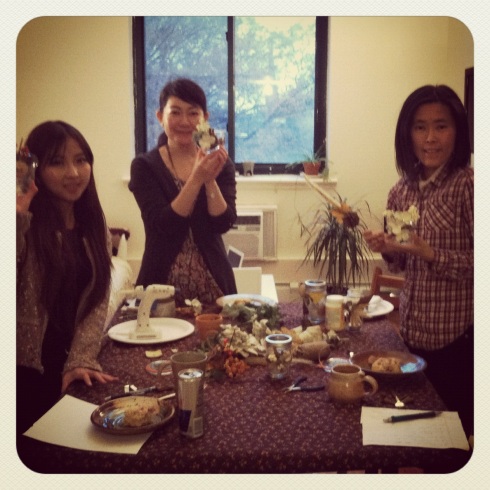This past Sunday I was given the opportunity meet and work with Myoho Asari, the woman who helped spread the shio-koji trend throughout Japan. For those of you who are not familiar with shio-koji, it is steamed rice containing koji spores (which contain enzymes) combined with salt. Koji are fermented with the salt which creates shio-koji. As Myoho-san pointed out at the workshop, most of us have eaten koji, even if we have no idea what it is. If you have eaten miso, soy sauce, or sake before, you have eaten koji! Koji is the starter ingredient for many of the integral foods found in the Japanese diet which are eaten world wide now. Shio-koji is basically a flavor enhancer that is all-natural and actually provides a variety of health benefits. It also serves as a probiotic, by providing the intestines with good bacteria that helps to maintain a healthy intestinal environment. You can find out more about koji as well as recipes on how to make shio-koji on Myoho san’s website: http://kojiya.jp/index.html
Now that I have introduced shio-koji, I would like to talk more about Myoho-san and her workshop held in Brooklyn this past Sunday. (Event Link) Myoho-san is a lovely woman who is very passionate about Koji and about life. I believe that her passion really generated in the room at the workshop last night and that the attendees walked away from the class with a new interest and enthusiasm about Koji. Myoho-san first talked about the variety of benefits as well as the background and history about Koji in Japan. She then invited some members from the audience to take part in making shio-koji. I have made shio-koji a few times before but I learned something new from Myoho-san. She really believes that it is important to treat koji as we would other living things because they are actually alive. Therefore the way in which she handles koji was completely different then how I had been handling it. In the mixing process of salt, koji and water, she uses her hands the whole time and first carefully breaks up the koji, thoroughly combines it with the salt, and then adds water and kneads the koji. Up until now I had just been throwing the ingredients together and mixing them with a wooden spatula, but I am sure that I won’t be doing that anymore now that I saw the way Myoho-san does it.
Myoho-san also demonstrated how to make sausage using shio-koji. The sausage that she made did not require the use of intestine skin, which I thought was very interesting. The shio-koji really made a difference in enhancing the flavor.
In the end everyone was able to taste a variety of foods using shio-koji. There were also foods made with just salt so that everyone could compare the taste of shio-koji and regular salt.
Myoho-san hopes to spread the knowledge and tradition of shio-koji to the United States and maybe the rest of the world. I really hope that her dream will come true.

This is what I use to make shio-koji, Eden Salt and Cold Mountain Rice Koji. In New York you can buy Cold Mountain Koji at Sunrise Japanese Market and Dainobu Japanese Market.
Unfortunately I wasn’t able to take pictures at the event as I was interpreting for Myoho san, but If you visit her website you can see more pictures of koji and her koji store in Japan!







